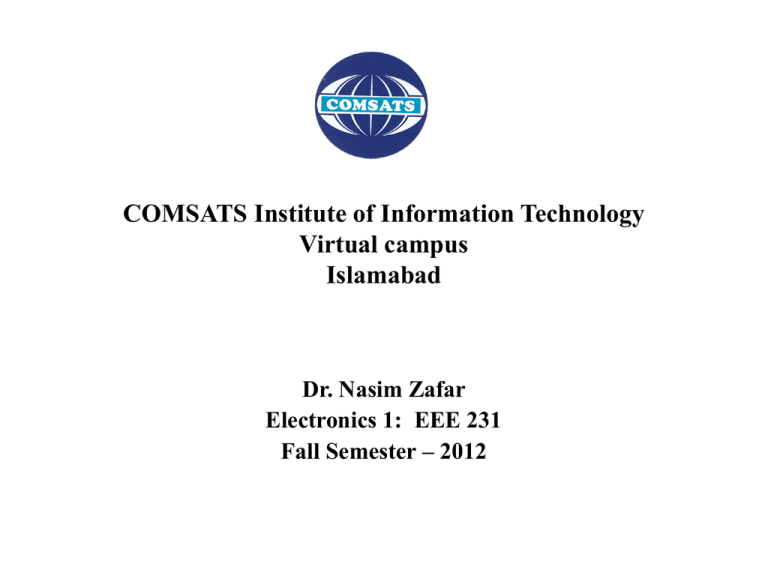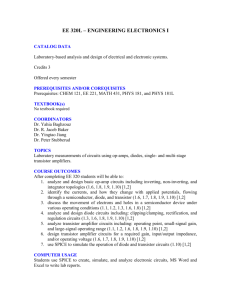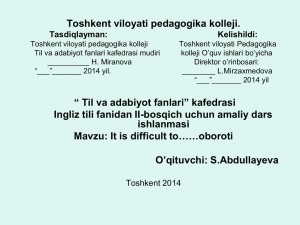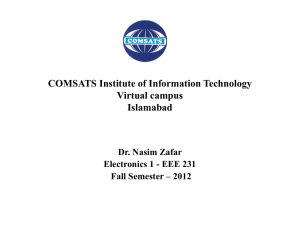(a) Fixed-Bias Circuit. - COMSATS Institute of Information
advertisement

COMSATS Institute of Information Technology Virtual campus Islamabad Dr. Nasim Zafar Electronics 1: EEE 231 Fall Semester – 2012 Transistor Biasing Circuits and Thermal Stability. Lecture No: 18 Contents: Introduction The Operating Point and Biasing Stability Fixed-Bias Circuits Fixed Bias with Emitter Resistance Voltage-Divider Bias Circuits Nasim Zafar 2 References: Microelectronic Circuits: Adel S. Sedra and Kenneth C. Smith. Electronic Devices : Thomas L. Floyd ( Prentice Hall ). Integrated Electronics Jacob Millman and Christos Halkias (McGraw-Hill). Electronic Devices and Circuit Theory: Robert Boylestad & Louis Nashelsky ( Prentice Hall ). Introductory Electronic Devices and Circuits: Robert T. Paynter. Nasim Zafar 3 References for this Lecture: Chapter No. 9 Microelectronic Circuits: Adel S. Sedra and Kenneth C. Smith. Integrated Electronics : Jacob Millman and Christos Halkias (McGraw-Hill). Nasim Zafar 4 Objectives: Discuss the concept of dc biasing of a transistor for the linear operation in the active region. Establish an operating point Q in this active region to provide appropriate potentials and currents. Analyze the voltage-divider bias, base bias, and collectorfeedback bias circuits. Establish a criterion for comparing the stability of different biasing circuits. Nasim Zafar 5 Transistor Biasing Circuits: an Introduction Biasing refers to the establishment of suitable dc values of different currents and voltages of a given transistor. Through proper biasing, a desired DC operating point or quiescent point; Q-Point of the transistor amplifier, in the active region (linear region) of the characteristics is obtained. The goal of amplification, in most cases, is to increase the amplitude of an ac signal without distortion or clipping the wave form. Nasim Zafar 6 Transistor Biasing Circuits: an Introduction The selection of a proper DC operating point or quiescent point, generally depends on the following factors: (a) The amplitude of the ac signal to be handled by the amplifier and distortion level in signal. Applying large ac voltages to the base would result in driving the collector current into saturation or cutoff regions resulting in a distorted or clipped wave form. (b) The load to which the amplifier is to work for a corresponding supply voltage. Nasim Zafar 7 The DC Operating Point: Biasing and Stability The goal of amplification, in most cases, is to increase the amplitude of an ac signal without distortion or clipping the wave form. Nasim Zafar 8 Transistor Output Characteristics: IC IC IB = 40mA IB = 30mA IB = 20mA IB = 10mA VCE Early voltage Cutoff region At a fixed IB, IC is not dependent on VCE Nasim Zafar 9 Transistor Output Characteristics: Load Line – Biasing and Stability The requirement is to set the Q-point such that that it does not go into the saturation or cutoff regions when an a ac signal is applied. Nasim Zafar 10 The DC Operating Point: Biasing and Stability Slope of the Load Line: VCC = VCE + VRC VCE = VCC -- VRC VCE = VCC -- IC RC VCC 1 I c ( )VCE Rc RC Nasim Zafar 11 The DC Operating Point: Biasing and Stability Load Line drawn on output characteristic curves. – Determines quiescent point, Q – Q is between saturation and cutoff Best Q for a linear amplifier: – Midway between saturation and cutoff. Nasim Zafar 12 The DC Operating Point: Biasing and Stability For this particular transistor we see that 30 mA of collector current is best for maximum amplification, giving equal amount above and below the Q-point. Nasim Zafar 13 The DC Operating Point: Biasing and Stability Q-Point and Current Gain βdc βdc not a constant βdc Dependent on: – Operating Point Q – Temperature Active region limited by – Maximum forward current, IC(MAX) – Maximum power dissipation, PD 14 Nasim Zafar The DC Operating Point: Biasing and Stability The DC operating point of a transistor amplifier shifts mainly due to changes in the temperature, since the transistor parameters: — β, ICO and VBE —are functions of temperature. 100 < βdc < 300 We will discuss some of the methods used for biasing the transistor circuits. Nasim Zafar 15 Transistor Biasing Circuits. Nasim Zafar 16 Transistor Biasing Circuits: Biasing - Circuit Configurations: 1. Fixed-Biased Transistor Circuits. 2. Fixed-Biased with Emitter Resistance Circuits. 3. Voltage-Divider-Biased Transistor Circuits. Nasim Zafar 17 Transistor Biasing Circuits: 1. Fixed-Biased Transistor Circuits. - Highly dependent on βdc 2. – – – – Fixed-Bias with Emitter Resistance Circuits. Add emitter resistor Greatly reduces effects of change of β Equations highly dependent on βdc 18 Nasim Zafar 1. Fixed-Biased Transistor Circuits. Single Power Supply Nasim Zafar 19 DC Voltages and Currents in a BJT: Active region - Amplifier: BJT acts as a signal amplifier. 1. B-E Junction Forward Biased C C VBE ≈ 0.7 V for Si IC B 2. B-C Junction Reverse Biased B IB IB E 3. KCL: IE = IC + IB Nasim Zafar IC IE IE E 20 1. Fixed-Biased Transistor Circuits: – Single Power Supply 21 Nasim Zafar 1. Transistor Fixed-Bias Circuits: Base–Emitter Loop: Collector–Emitter Loop: VCE = VCC -- IC RL (a) Fixed-Bias Circuit. Nasim Zafar (b) Equivalent Circuit. 22 1. Transistor Fixed-Bias Circuits: Current-Voltage Equations for Fixed-Bias circuits: VCC VBE IB RB IC I B VCE VCC I C RC 23 Nasim Zafar 2. Fixed-Bias with Emitter Resistance Single Power Supply Nasim Zafar 24 2. Fixed-Bias with Emitter Resistance: 1. Base-Emitter Loop: KCL: IE = IC + IB The emitter current can be written as: From the above two equation we get: Fixed-Bias Circuit with Emitter Resistance Nasim Zafar 25 2. Fixed-Bias with Emitter Resistance. 2. Collector-Emitter Loop with the base current known, IC can be easily calculated by the relation I C = β I B. Fixed-Bias Circuit with Emitter Resistance Nasim Zafar 26 3. Voltage-Divider-Bias Circuits. Nasim Zafar 27 3. Voltage-Divider-Bias Circuits: Voltage-Divider Bias Circuits: – Sometimes referred to as Universal-Bias Circuit: – Most stable – Need IB << IC 1 – Make R2 10 RE – Simple Voltage divider between VCC, Base, and ground. 28 Nasim Zafar 3. Voltage-Divider-Bias Circuits: Voltage-divider biasing circuit is the most widely used type of transistor biasing circuit. Only one power supply is needed. and voltage-divider bias is more stable ( independent) than other bias types. Nasim Zafar 29 3. Voltage-Divider-Bias Circuits: For the transistor circuit shown here, R1 and R2 set up a voltage divider on the base, voltage to the point A (base). The resistance to ground from the base is not significant enough to consider in most cases. Remember, the basic operation of the transistor has not changed. Nasim Zafar 30 3. Voltage-Divider-Bias Circuits: Voltage-Divider Bias circuit Simplified Voltage-Divider circuit Nasim Zafar 31 3. Voltage-Divider-Bias Circuits: Determination of VTh – the Thevenin Voltage. 32 Nasim Zafar 3. Voltage-Divider-Bias Circuits: 1. Base Emitter Loop: The Thevenin equivalent Voltage for the input circuit is given by: and Resistance for the input circuit: Nasim Zafar 33 3. Voltage-Divider Bias Circuits: 1. Base-Emitter Loop: The KVL equation for the input circuit: Nasim Zafar 34 3. Voltage-Divider Biasing Circuits: 2. Collector-Emitter Loop: VE I E IC RE VCE VCC ( RC RE ) I C 35 Nasim Zafar 3. Voltage-Divider Biasing Circuits: Voltage Divider Equations: VE IE IC RE VCE VCC ( RC RE ) I C VBB VBE IB RBB RE ( 1) IC I B VCE VCC ( RC RE ) I C 36 Nasim Zafar Emitter Biased Transistor Circuits: This type of circuit is independent of making it as stable as the voltagedivider type, The drawback is that it requires two power supplies. Two key equations for analysis of this type of bias circuit are given below. With these two currents known we can apply Ohm’s law and Kirchhoff's law to solve for the voltages. IB ≈ IE/ IC ≈ IE ≈( -VEE-VBE)/(RE + RB/DC) Nasim Zafar 37 Summary: βdc Dependent on: – Operating Point Q – Temperature – For stability of the Q-point: – Make R2 101 RE Nasim Zafar 38






